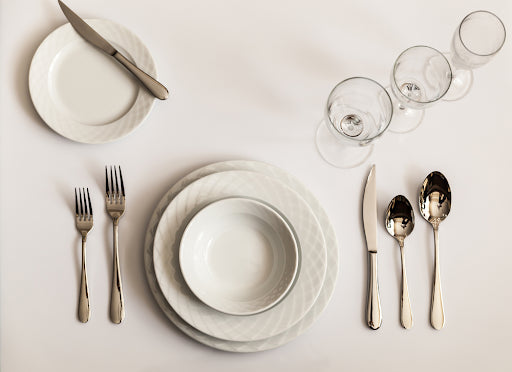Which Crockery is Best for a Restaurant?
Posted by VANEET KOCHHAR

Consumers play an essential role in forming good impressions; therefore, choosing the best restaurant crockery is necessary. Tableware impacts not only what consumers consume while eating but also the environment they are placed in within your eating joint. It does not matter whether you run a high-class restaurant or a popular cafeteria – selecting the proper dishware and utensils would protect them from breaking and, at the same time, would improve their appearance.
It is now appropriate for crockery in restaurants, and there are some aspects that you must look at when choosing ceramics.
1. Porcelain Plates: Elegance Meets Durability
Porcelain is among the most popular minerals due to its elegant appearance and exquisite look. It is made from materials that are resistant to chips and thus can be used repeatedly for fine-dining restaurants. The material used is smooth, and the structure and designs are classy to enable them to fit elegant surroundings. For businesses interested in an elegant and durable material, porcelain is great.
2. Ceramic Plates: Versatile and Stylish
Ceramic plates are timeless, affordable, versatile, plant-based, and suitable for all types of dining. Ceramic crockery comes in different forms, including shapes, colors, and textures, and it can easily match your restaurant’s theme. For instance, Ceramic Cream Matt Crockery is best suited for modern products without an upmarket appearance. With a density just a tad more than porcelain, ceramic plates are strong and can easily be used for everyday and even more refined dining.
3. Melamine Plates: Practical and Budget-Friendly
For intense use in restaurants, cafes, snack bars, takeaways, or any place where a huge number of dishes are served, it is pertinent to use melamine plates. Melamine is durable, has low impedance, is food-secure, and is resilient against breakage while being affordable and available in diverse designs. These plates can mimic some of the other and more expensive types of crockery and, hence, are widely used by most restaurant owners.
4. Key Factors to Consider When You Buy Restaurant Crockery
Durability:
Select strong utensils for the ceremony that can easily be washed and handled occasionally. Porcelain and ceramic are suitable for fine dining since they are hard-wearing, while melamine is appropriate in places with heavy traffic.
Aesthetic Appeal:
Your tableware should be compatible with the rest of the décor and feel of your restaurant. Formal settings such as invitations for weddings or formal dinners and porcelain or ceramics can be used. In contrast, melamine can be used for informal occasions such as invitations for informal picnics or barbeque.
Functionality:
Determine the needs of the menu to identify them. For instance, soup bowls, serving platters, and dessert plates might be useful necessities in one eatery but not at all in another.
Quality and costs:
The quality of the constructed home must be interrelated to the money required to build the home. Porcelain and ceramic have better gloss and durability than the other surfaces but have a relatively higher cost than the other types; melamine, on the other hand, has a lesser cost.
Why Quality Crockery Matters?
Good quality utensils mean good sales for your business, so sourcing for quality crockery boosts your brand. It also cuts down on replacements, reducing overall overheads in the longer run.
When sourcing your crockery, consider reliable hotel equipment suppliers who offer a variety of options to suit your requirements.
Conclusion
Choosing the right restaurant dinnerware is about function, design, and affordability. Whether you choose porcelain enameled tableware, ceramic finish tableware, or melamine tableware, the right choice will reach your diners’ fingertips in your restaurants.
To find high-quality crockeries, including Ceramic Cream Matt Crockery, it is necessary to approach reliable companies that deal with crockery products such as tableware.
Let your restaurant stand out with the right crockery—because every dish counts!


